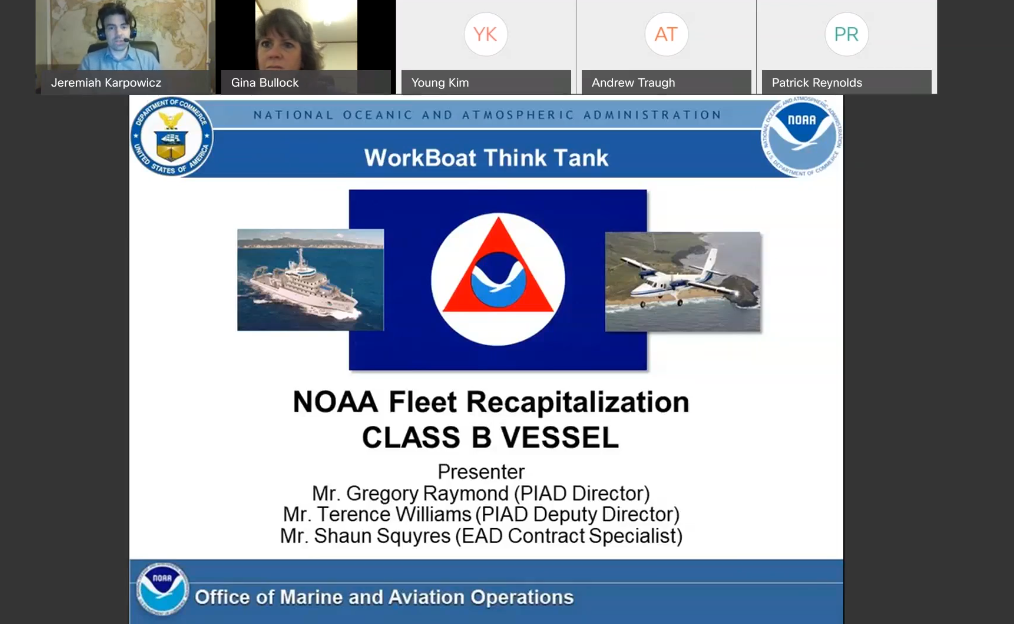Representatives from NOAA recently discussed the specific requirements for the development of a brand new ship class. The current acquisition strategy and approach to creating NOAA Class B: TLR was the focus of the Doing Business with the U.S. Government – The National Oceanic and Atmospheric Administration – Oceanographic Research Vessels webinar.
While the information that was laid out during the recent was incredibly thorough, Workboat webinars provide the live audience with a chance to ask the presenters specific questions and further explore the topics being discussed. We connected with the presenters to capture answers to all of the questions that were asked during the webinar. The presenters also answered a handful of the questions that came in at the end of the webinar, underscoring the importance of tuning into these webinars when they’re live.
To learn more about doing business with the U.S. government, please check out our schedule of upcoming webinars but also sign up for our weekly newsletters if you’re not already subscribed.
Audience Question: Will the platform be compliant to EPA Tier 4?
Answer: Yes. IMO Tier III also required.
Audience Question: Will the ship be a clean sheet design, or do you look for proven designs?
Answer: The government intends to provide a bare hull form design. The intent is for the builders to complete all other design work, including: hull appendages, propulsor selection, arrangements, and structures.
Audience Question: We are a tier 2 or 3 supplier. Is there a way I can find out who is bidding?
Answer: The government will post a list of interested vendors via the government-wide point of entry.
Audience Question: Are you open to using Diesel Outboards on the Small craft?
Answer: Yes, the current intention is to not restrict the arrangement of the crewed craft propulsion other than requiring it be diesel powered.
Audience Question: Does NOAA have a set of approved drawings and specifications for industry to bid to or does NOAA expect industry to provide their own design?
Answer: The government intends to provide a bare hull form design. The intent is for the builders to complete all other design work, including: hull appendages, propulsor selection, arrangements, and structures.
Audience Question: Will the vessels ever operate in freshwater as well as Marine environments?
Answer: Vessels are not intended for freshwater operation.
Audience Question: Is it anticipated that coxswain training, including launch and recovery operations training, will be included as part of the procurement for the small boats or would this be responsibility of NOAA after taking possession?
Answer: Training for the crew to use shipboard equipment is part of the vessel procurement contract.
Audience Question: Has the vessel already been fully engineered?
Answer: No. The government intends to provide a bare hull form design. The intent is for the builders to complete all other design work, including: hull appendages, propulsor selection, arrangements, and structures.
Audience Question: It was stated that the Buy American Act will have implications for “raw materials." Will the Buy America Act have implications for manufactured goods for outfitting the ship?
Answer: The resultant contract will adhere to the Buy American Act.
Audience Question: Is the small craft gas or diesel powered?
Answer: Diesel.
Audience Question: Is the anticipated RFP release fourth quarter FY21 or CY21?
Answer: FY21.
Audience Question: What level of design will be required with the proposal response?
Answer: Requirements for proposal will be included in the RFP.
Audience Question: How do I become a registered vendor?
Answer: The government POC for this requirement is Shaun Squyres. Interested vendors who provide their information will be put on a list of interested vendors that will be posted on the government-wide point of entry.
Audience Question: Permanent Ballast. This is a big deviation on all the research vessels we have done for the government and I am very happy to see that it is allowed. Generally, research vessels have a light density due to the internal volume required to house the equipment and provide the proper areas and volumes for the missions. That creates a vessel that tents to be light and in addition the requirements of future growth and future additions changes weights allowances, creates an issue on bringing the vessel to proper draft without use of permanent ballast. Could you define what would be the restrictions on using the permanent ballast besides what is already stated in the specifications. Could it be allowed for improving stability or just for trim and draft corrections?
Answer: There is not an intent to restrict how permanent ballast is used, if it is required.
Audience Question: Z Drive Propulsion. NOAA is requesting or permitting the use of azimuth propulsion units. It has been difficult to use these units in research vessels due to noise restrictions. The required power may be beyond the available power from manufacturers that could meet noise levels. Are there other types of propulsion that could be accepted by NOAA?
Answer: The current requirement is for L-Drive-style azimuthing propulsors to be used.
Audience Question: Who is doing the vessel design?
Answer: The government intends to provide a bare hull form design. The intent is for the builders to complete all other design work, including: hull appendages, propulsor selection, arrangements, and structures.
Audience Question: Who will be responsible for speed, stability, internal usable volume, bubble sweep down and displacement of the design if NOAA requires to fit to the hull form provided by NOAA?
Answer: Delineation of risks and design responsibilities will be defined in the final RFP.
Audience Question: Are interested vendors able to be added even if they didn't respond to the draft RFP?
Answer: Yes, interested vendors who provide their information to Shaun Squyres will be put on a list of interested vendors that will be posted on the government-wide point of entry.
Audience Question: Is there a POC for follow-up questions? How do we set up a meeting to discuss the draft RFP?
Answer: The government POC for this requirement is Shaun Squyres and can be reached via email at [email protected]. Please provide a response to the draft RFP and the technical team will review accordingly and determine whether a one-on-one meeting is warranted.
Watch the Doing Business with the U.S. Government – The National Oceanic and Atmospheric Administration – Oceanographic Research Vessels webinar




